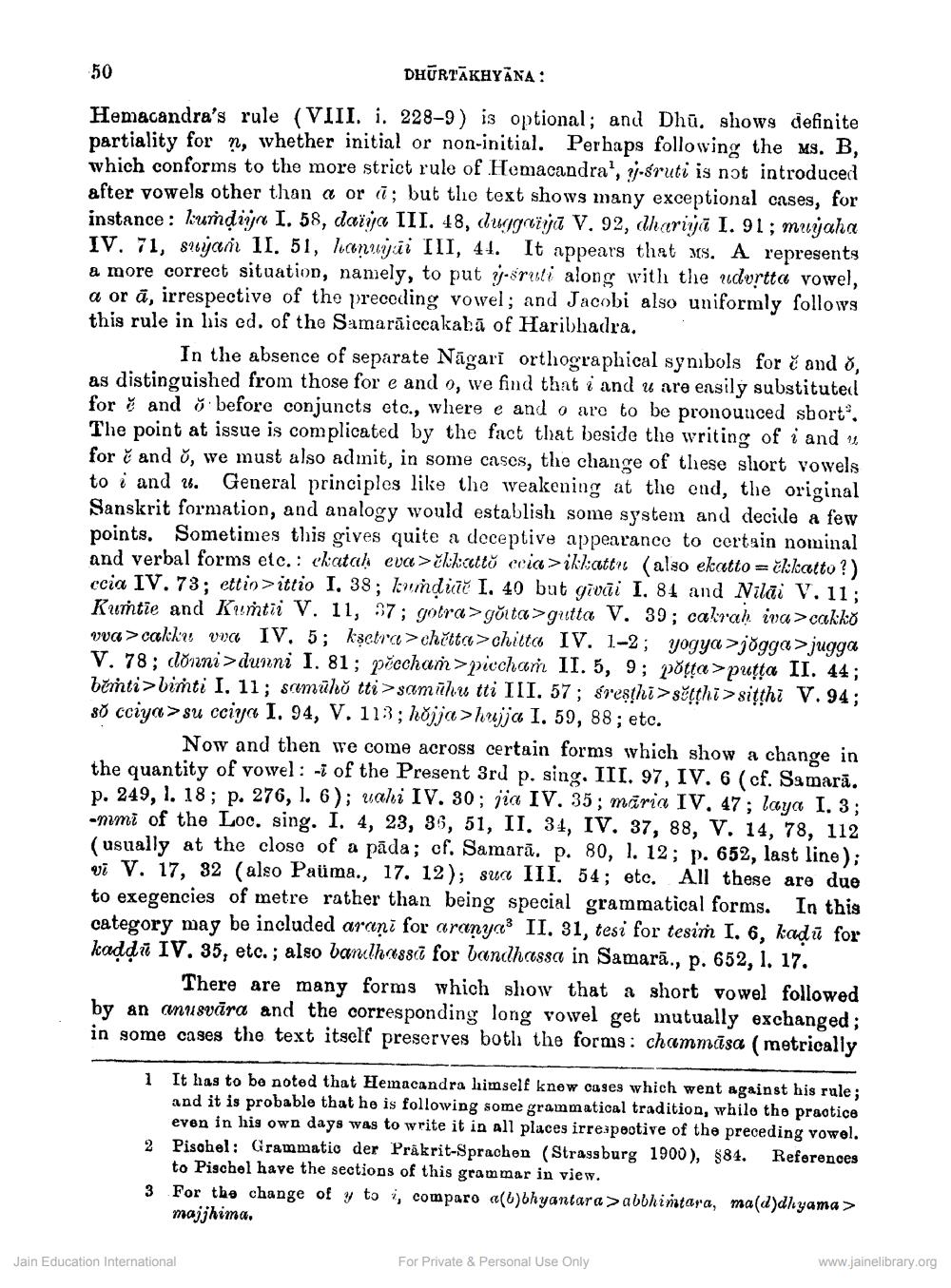________________
50
DHĒRTĀKHYANA:
Hemacandra's rule (VIII. i. 228-9) is optional; and Dhū. shows definite partiality forn, whether initial or non-initial. Perhaps following the ms. B, which conforms to the more strict rule of Hemacandra', 4j-sruti is not introduced after vowels other than a or ; but tlie text shows many exceptional cases, for instance: kurdiyn I. 58, dažija III. 48, duggarija V. 92, dhariija I. 91; mujaha IV. 71, sujan II. 51, lconuijii III, 4t. It appears that us. A represents a more correct situation, namely, to put y-sruti along with the adurtta vowel, a or ā, irrespective of the preceding vowel; and Jacobi also uniformly follows this rule in his ed. of the Samarāiccakahā of Haribhadra.
In the absence of separate Nāgari orthographical synbols for č and , as distinguished from those for e and o, we find that i and u are easily substituted for Ở and ở before conjuncts etc., where e and o are to be pronounced sbort. The point at issue is complicated by the fact that beside the writing of i and 2 for and , we must also admit, in some cases, the change of these short vowels to i and 2. General principles like the weakening at the end, the original Sanskrit formation, and analogy would establish some system and decide a few points. Sometimes this gives quite a deceptive appearance to certain nominal and verbal forms etc.: ckatah eva >ělkettő ccia >iklattı (also ekatto = ckkatto?) ccia IV. 73; ettio >ittio I, 38; kunditě I. 40 but givāi I. 84 and Nilai V. 11; Kumtie and Kumtii V. 11, 37; gotra > gõita >gutta V. 39; cakrah iva >cakko vva >cakku vva IV. 5; kşetra >chetta>chitta IV. 1-2; yogya > jogga >jugga V. 78; donni > dunni I. 81; pēcchań>picchan II. 5, 9; poțța>putta II. 44; birinti>binti I. 11; samūho tti >samūhu tti III. 57; sresthi >stthi>sitthi V. 94; so cciya > su ccirco I. 94, V. 113; hojja>huja I, 59, 88; etc.
Now and then we come across certain forms which show a change in the quantity of vowel: -1 of the Present 3rd p. sing. III. 97, IV. 6 (cf. Samarā. p. 249, 1. 18; p. 276, 1. 6); uahi IV. 30; jia IV, 35; maria IV, 47; laya I. 3; -mmi of the Loc. sing. I. 4, 23, 35, 51, II. 34, IV. 37, 88, V. 14, 78, 112 (usually at the close of a pāda; cf. Samarā. p. 80, 1. 12; p. 652, last line); vi V. 17, 32 (also Paüma., 17. 12); suc III, 54; etc. All these are due to exegencies of metre rather than being special grammatical forms. In this category may be included arani for aranya: II. 31, tesi for tesiṁ I. 6, kadū for kaddu IV. 35, etc.; also banilho88c1 for banchassa in Samarā., p. 652, 1. 17.
There are many forms which show that a short vowel followed by an anusvāra and the corresponding long vowel get mutually exchanged; in some cases the text itself preserves both the forms: chammaisa (metrically
1 It has to be noted that Hemacandra limself knew cases which went against his rule;
and it is probable that he is following some grammatical tradition, whilo the practice
even in his own days was to write it in all places irreapective of the preceding vowel. 2 Pisohel: Grammatio der Prakrit-Sprachen (Strassburg 1900), $84. References
to Pischel have the sections of this grammar in view. 3 For the change of y to y comparo a(6)bhyantara >abbhintara, ma(d)dhyama >
majjhima.
Jain Education International
www.jainelibrary.org
For Private & Personal Use Only




